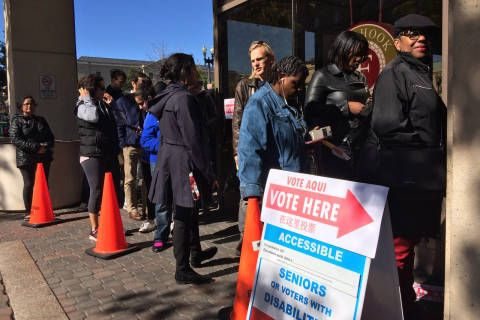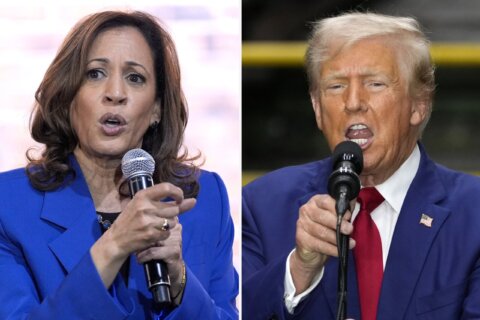Editor’s note: This article is part of a WTOP series previewing races and ballot measures, and providing voting information for residents of D.C., Virginia and Maryland.
WASHINGTON — When D.C. voters head to the polls next week, they’ll have the option to put their stamp of approval on a bid to make the District the 51st state.
For the first time since the 1980s the often-quixotic campaign for D.C. statehood is back on the ballot: D.C. residents will vote Nov. 8 whether to sign off on a recently drafted constitution for the proposed state, approve newly redrawn borders and give District officials the go-ahead to push the U.S. Congress to act on their petition for statehood.
But even if D.C. voters approve the advisory referendum — even by overwhelming margins — the prospect of D.C. becoming a state remains a long shot, according to most political experts.
Here are five things to know about the D.C. statehood referendum on the ballot:
The name game
A draft constitution issued over the summer by a special five-member D.C. Statehood Commission, led by D.C. Mayor Muriel Bowser, proposed calling the state “New Columbia” — a name long associated with the statehood movement and previously approved by D.C. voters in the early 1980s.
But not everyone was happy with that blast from the past. A number of public comments on the draft constitution took issue with the proposed name; even some D.C. pols seemed hesitant.
D.C. council member Jack Evans, who represents Ward 2, called the name “absurd” and “ridiculous,” and at an Oct. 18 council meeting, just a few weeks out from the election, introduced a last-minute measure seeking to rename the still-theoretical state.
The D.C. Council unanimously approved Evans’ amendment striking all references to New Columbia from the proposed constitution in favor of simply “Washington D.C.”
At that same meeting, council members also decided D.C. wouldn’t stand for District of Columbia anymore but instead for Douglass Commonwealth — a nod to abolitionist and D.C. resident Frederick Douglass.
Utopia lost
The recent history of the push for D.C. statehood dates back decades.
In the early 1980s, a constitutional convention made up of D.C. residents met for months, eventually drafting an 18,000-word constitution (more than twice as long as the U.S. Constitution) containing an “unorthodox” Bill of Rights that guaranteed every District resident a minimum income and would have allowed government workers, including police and firefighters, the right to strike.
While advocates eventually settled on the now-contested “New Columbia,” for a name, others considered by the constitutional convention included Anacostia, Potomac — even Utopia.
D.C. voters approved the New Columbia constitution in 1982 by a margin of 53 to 47 percent. It only needed a simple majority in the House and Senate to be approved, but Congress never acted on it, according to a history of the effort summarized by the current D.C. statehood commission.
In 1987, the D.C. Council took up the issue again, revising the earlier constitution slightly and again asking Congress to sign off through an act of legislation.
“During our research, we did not find that any president or any session of the Congress have ever responded to the 1987 submission,” the statehood commission’s report stated.
Slightly shrinking borders
While statehood would mean a bigger voice for D.C. residents on the national stage, the square footage of the proposed state would actually decrease slightly.
That’s because the U.S. Constitution specifically requires a federal district — which expressly can’t be a state — to house the seat of U.S. government. So D.C. statehood advocates propose carving out the areas directly around the Capitol, White House and National Mall, which would remain a separate federal city or “enclave,” and not part of the new D.C. state.
After all, the U.S. Constitution doesn’t say how big the specified federal district has to be — only that it can’t exceed 100 square miles (D.C. is currently about 68 square miles).
Get ready for a governor
One of the key aims of the proposed D.C. constitution is to “promote stability” and preserve the District’s basic current governing structure.
Still, you’d have to get used to a new range of titles for D.C. officials. The mayor would become a governor, but still serve a four-year term with elections held in even years when there is no presidential election.
The 13-member D.C. Council would expand to a 21-member Legislative Assembly: Two members elected from each of D.C.’s eight legislative districts, four at-large members and an elected speaker of the assembly replacing the current council chair.
The Advisory Neighborhood Commission system would remain largely unchanged, and D.C. would get a locally controlled court system.
What happens next?
The push for statehood follows what local leaders call the Tennessee Plan.
In the late 1700s, residents of the then-federal territory drew up a constitution, asked voters to sign off on it and, when successful, presented the U.S. Congress with the results. Presto — the 16th state was born.
If a majority of D.C. residents approve the referendum Nov. 8, District leaders say they’ll take their case to Congress as they did in the early 1980s.
Mayor Muriel Bowser has said she’s planned a big push for early 2017 to present the new president and new Congress the official petition for statehood.
But even with overwhelming approval at the polls, the bid for statehood remains a longshot effort, especially if Republicans retain control of Congress, since they are generally not amenable to handing the solid-blue Democratic District two seats in the Senate.
Independent member of the D.C. council David Grosso has said the effort needs to be backed by a major public-relations campaign, which could top more than $100 million.
So far, the Statehood YES! campaign has spent just $197.50 this year and raised just $5,000, according to online campaign expenditure records maintained by the D.C. Office of Campaign Finance.







